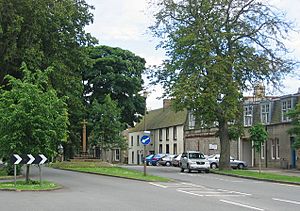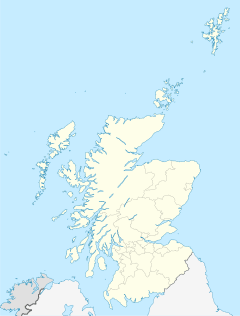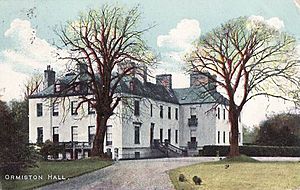Ormiston facts for kids
Quick facts for kids Ormiston |
|
|---|---|
 Mercat Cross in Main Street, Ormiston |
|
| Population | 2,110 (2020) |
| OS grid reference | NT410691 |
| Council area |
|
| Lieutenancy area | |
| Country | Scotland |
| Sovereign state | United Kingdom |
| Post town | TRANENT |
| Postcode district | EH35 |
| Dialling code | 01875 |
| Ambulance | Scottish |
| EU Parliament | Scotland |
| UK Parliament |
|
| Scottish Parliament |
|
Ormiston is a village in East Lothian, Scotland. It is located near Tranent, Humbie, Pencaitland, and Cranston. The village sits on the north bank of the River Tyne. It is about 84 meters (276 feet) above sea level.
Ormiston holds a special place in Scottish history. It was the very first planned village in Scotland. It was started in 1735 by John Cockburn. He was an important person who helped kick off the Agricultural Revolution. This was a time of big changes in farming.
Contents
What Does the Name Ormiston Mean?
The name Ormiston comes from an old Anglian settler named Ormr. His name means 'serpent' or 'snake'. Ormr's family owned the land during the 1100s and 1200s. You might find the name Ormiston or 'Ormistoun' as a surname. The name Ormr also appears in other English place names, like Ormskirk.
The second part of the name, 'toun', used to be spelled 'toun'. It comes from old languages and means 'farmstead' or 'farm and its buildings'. It doesn't mean 'town' in the way we use it today.
There was another "Ormiston" in Berwickshire. The Cockburn family might have brought the name from that place to East Lothian in the 1300s.
A Look Back at Ormiston's History
Ormiston has a rich past with interesting people and events.
Famous Residents and Visitors
The poet Elizabeth Douglas lived in Ormiston. She was married to Samuel Cockburn of Templehall. In 1587, she wrote sonnets for a book by the poet William Fowler.
King James VI visited Ormiston to hunt deer. He came on November 22, 1588, and again in October 1599.
The First Planned Village
The "model village" of Ormiston was designed in 1736. This happened when John Cockburn became the new laird, or landowner. He had inherited the estate from his uncle.
William Begg, who was the nephew of the famous poet Robert Burns, became the schoolmaster in Ormiston. His whole family moved to live with him at the schoolhouse. Isabella Begg, Robert Burns's sister, also ran a school here. The family later moved to nearby Tranent in 1834.
What Ormiston Looks Like Today
Ormiston mainly has a wide Main Street. There are rows of mostly two-story houses on both sides. The street crosses two bridges. One goes over an old railway line that is no longer used. The other is a narrow bridge over the River Tyne.
Early Industries and Changes
When John Cockburn first planned the village, he built homes for artisans and small home-based businesses. These included spinning and weaving. He hoped to make money from these industries. However, he didn't get the returns he expected. So, he sold the village to the Earl of Hopetoun in 1747.
The linen trade didn't do well, and a distillery closed by 1811. A brewery and one of Scotland's first bleachfields (places to whiten cloth) were also built here. Later, Ormiston became a mining village. The Ormiston Coal Company worked coal mines south of Tranent.
Ormiston Coal Mines
Several important coal mines were located near Ormiston:
- Limeylands: This mine opened in 1895 and closed in 1954. Its coal processing plant was used until 1958.
- Tynemount: Opened in 1924, this mine closed in 1952.
- Oxenford No. 2: This mine started in 1926 and closed in 1950.
- Oxenford No. 3: A new mine very close by, opened by the National Coal Board, but it closed in 1952.
- Winton Mine: First used for air circulation in 1943, it became a mine in 1952 and closed in 1962.
Ormiston Hall and Its Surroundings
Ormiston Hall was a large house located south of the village. It was built for John Cockburn between 1745 and 1748. It was later made bigger for the Earl of Hopetoun. The Hall is now in ruins because of a fire during World War II. New homes have been built in and around its old grounds.
You can still see the remains of the old St Giles Parish Church nearby. This church existed before the Scottish Reformation. The Great Yew of Ormiston is a very old tree that grows south of the hall's site. It is a special type of yew tree that grows by layering its branches. Experts believe it could be up to one thousand years old!
Shops and Businesses in Ormiston
Ormiston has several shops for its residents. On Main Street, you can find:
- The Co-operative Store
- Post Office Ltd – This shop also acts as a grocery store with a Post Office counter.
Elsewhere in the village, there is:
- The Little Superstore
Many small businesses also operate from units in the Cockburn Halls. This building used to be the Miners' Welfare building.
The Mercat Cross
The Mercat Cross on Main Street is from the 1400s. It is unusual because of its true cruciform (cross) shape. It stands on three modern steps and is surrounded by a railing. Historic Scotland looks after this important historical monument.
Famous People from Ormiston
- Robert Moffat (1795–1883): He was a Scottish missionary who was born here. A memorial stands in his honor. He was also the father-in-law of David Livingstone, the famous explorer.
- George Wishart: This religious reformer was captured in December 1545 while hiding at Ormiston Hall.
- John Cockburn of Ormiston (died 1583): A Protestant landowner. His brother, Ninian Cockburn (died 1579), was a political agent.
- John Cockburn of Ormiston (c. 1685–1758): A landowner and important person in farming reform.
- Charles Maclaren: A journalist and geologist who helped start The Scotsman newspaper.
- Col. James Burd: A hero from the French and Indian War and a leader in Pennsylvania before the American Revolution.
Photo gallery
See also
 In Spanish: Ormiston para niños
In Spanish: Ormiston para niños






